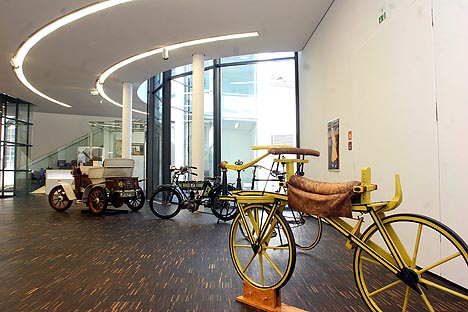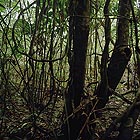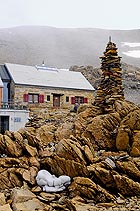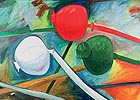
translated and summarized by: Liz Wollner-Grandville,
English summary August 10 - 22
Museum für Kunst und Technik des 19. Jahrhunderts: Travelling. A Century in Motion
Capital of the season
The capital of the 19th century was in actual fact not Paris but Baden-Baden. Like all rivers flow into the sea, Baden-Baden attracts beautiful women during the summer season. This has little to do with taking having a treatment at the spa, more with being seen, visiting the casino, the feeling of “being at the right place at the right time”.
Consequently, a Museum for 19th Century Art and Technology should be located in Baden Baden. Since the beginning of April, the museum supplements the Kunsthalle, the Burda Collection, and the Stadtmuseum, which are all already situated at the “museum mile” on Lichtentaler Allee. The museum is funded by the entrepreneur Wolfgang Grenke and the castle dating back to 1820, reconstructed by Friedrich Weinbrenner, at one time under the ownership of Amschel Mayer Rothschild and then again the Swedish royal family. Since 1873, it accommodates the “International Club” as well as the chess club, and both still have heir premises in the “Culture House LA8”. A glass restaurant-loggia was added on the side and the museum itself is located in the inner court of the new building. While the footprint of the house encompasses 3.750 square meters, only 400 m2 are designated exhibition space. The exhibitions alter every six months and are accompanied by symposiums devoted to 19th century art, culture, and technology.
The opening exhibition focussed on travelling during the 19th century, which reached new dimensions on account of the means of transportation unknown until then. On the artistic level, the topics Rhein River romanticism, the south and the exotic are documented, as well as the simulation of travelling, similar to the recent focus at the Wien Museum, next to photographic souvenirs, travel guides, travel games and historic means of transport, complemented by stereoscopic photographs of 19th century Baden-Baden. The minimal exhibition space, which is also full of nooks and crannies, only allows for a selective dealing with the topic. May the museum hold its high aspirations and hopefully receive more space in the near future.
By Iris Meder
Museum für Kunst und Technik des 19 Jahrhunderts
76530 Baden-Baden, Lichtentaler Allee 8, until 06.09.09
www.museum.la8.de
Bawag Contemporary: Young and Reckless 9 – Oliver Ottenschläger
Between space and non-space
The Young & Reckless series shown at the Bawag Contemporary presents conceptual works of a predominantly young and not necessarily ubiquitous group of artists to a wide audience.
The current exhibit of Oliver Ottenschläger’s works displays an extract of his photographic work dealing with space in tune with nature as well as culture-technologically modified space. A series of rain forest close-ups shot with a medium format camera are juxtaposed with photos of walls revealing dusty outlines of paintings, which no longer hang there. Minimalistic conceptualized spaces evolve, in which Ottenschläger researches empty spaces of differing cultural and vegetative types.
He advanced deep into the Indian and Indonesian rain forest to shoot close-ups of leaves and trees. Through the extreme close-up character the surroundings with their dense vegetation creating the impression to be blocked-out and simultaneously point to the human emptiness, which seemingly dominates this kind of vegetation.
Only through the camera does this normally not perceived space becomes visible and thereby become part of a cultural memory. The latter disappears on the hotel room walls, from which the artist removed the culturally developed artefacts to point to the normally not visible. Thereby he tracks down spaces that do not exist outside of the normal perception and as such become the main themes.
The synthesis of the almost white and chlorophyll-tinctured green pictures develops into a surface foil, unveiling the traces of non-spaces and pointing to interspaces manipulated by humans, which can be read as narrations of biological and socio-technological developments.
By Walter Seidl
Bawag Contemporary
1060 Vienna, Barnabitengasse 11 – 13, until 30.08.09
www.bwagcontemporary.at
Wildstrubelhütte: Hiking-destination Art: Insight and Outlook
Fabulous views and artificial worlds – the Wildstrubelhütte
In 1895, Georg Simmel wrote, “I think that the educational benefit of alpine travel is very minor.” (Alpine Travel, 1895). This summer five huts of the Swiss Alpine Club, (SAC) offer intellectual pleasures in addition to the alpine glow and fitness gained through climbing. The SAC cultural commission invited the curator Andreas Fiedler to organize an exhibition at five mountain huts in the four different language regions of Switzerland. Following the exhibit “high up” at the Kunstmuseum Thun in 2005, this is the 24th exhibition organized by the SAC together with the Swiss Artists Association.
Installations by 14 artists are shown at the different venues. Yves Netzhammer’s flags, corresponding with the ever-present yellow signposts with their red-and-white tips, are found at all five huts. His “wind landscapes” with the words “language scraps” or “bacteria” stimulate intense discussions among the visitors. The audience, of which some are very art-distant and others art loving, examines the artistic ongoing partly amused and partly suspicious. Judith Albert’s invention of the holy “San Carlo de Monte Grande” the “protector of the mountains and the everlasting ice” is offered in a portable matchbox. The stone inside the matchbox is meant to be placed at a location found worthy of protection. After the mountaineers reached the summit and return to the valley and finally rid themselves of the heavy backpack it is very likely that one or the other matchbox fell into oblivion and was taken home.
Georg Steinmann’s foggy and mysterious mountain images together with the “Point de Vue” postmark by Ariane Epar can be mailed directly from the Wildstrubelhütte. Postcards created by the hosts of the huts are also displayed, but they are by no means part of the art project. They depict the unbelievable sunset and the impressive summit view of the glacier de la Pleine Morte.
On the lower floor, the artist duo Monica Studer and Christoph van den Berg installed a wooden zograscope, however, unfortunately with a fare too large spy hole. It reveals the view of a computer-generated mountain world slowly passing by. Just like Markus Schwander’s stone-like sculptures, all stone formations or panoramas were artificially assembled. As artificially formed mountain worlds they do not compete with the real mountain world but offer a new cosmos in the form of a new level of thought.
By Marianne Wagner
Wildstrubelhütte
Lenk, until 25.10.09
www.sac-cas.ch/wildstrubelhuette.1483.0.html
Neue Galerie am Landesmusum Joanneum: Accent Hungary: Young Art 1960 – 1990
Collection without historic distance
Already the former head of the Neue Galerie, Wilfried Skreiner, recognized the potential of Graz as a gateway to Southern and Eastern Europe. At a time when our neighbors in the East and Southeast were not easy to reach, although they were so close, the “International Artists Weeks in Styria” and the “trigon Biennal”, paid attention to artists from these countries - to an extent they would have never reached in the West. “Accent Hungary” presents works from Hungarian institutions, which are historic documents of the activities of the Neue Galerie, and also allow a rare look at Hungary’s artistic development. The time frame was expanded to allow a more thorough comprehension of the works and includes interwar period paintings by Laszlo Moholy-Nagy or by Victor Vasarely from the 50s, with the quality of the three Vasarelys clearly standing out.
The works are arranged by topics; chronology plays a minor role. The main emphasis is put on paintings but there are also a few photographs on display (by Dora Maurer, Laszlo Valko,Andras Baranyay), as well as a handful of sculptures, among them an object by Beata Veszely and a wall sculpture by Roza El-Hassan.
The catalogue points to the fact that the collection developed without historical distance and that even if it may not be complete, it is significant because of its directness. Due to its scientific research and what it offers the onlooker an interesting art historic framework evolved.
This is a calm exhibition. One can wander through the halls in a relaxed and contemplative way and discover one or the other work which one will enjoy remembering.
By Nora Theiss
Neue Galerie am Landesmuseum Joanneum
8010 Graz, Sackstraße 16, until 06.09.09
www.neuegalerie.at
Mehr Texte von translated and summarized by: Liz Wollner-Grandville


 Teilen
Teilen





